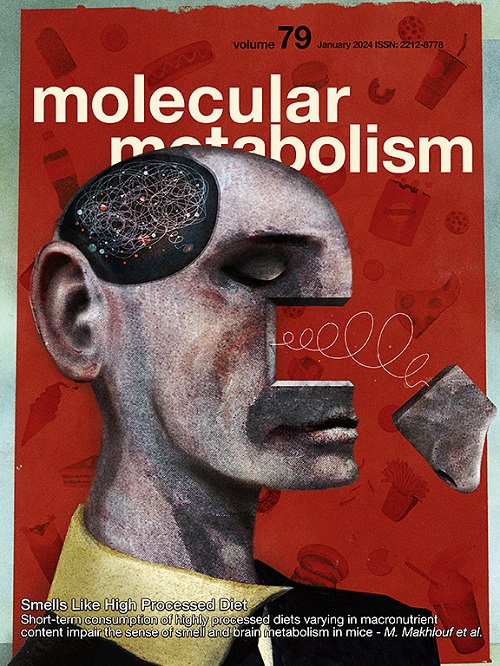Gut microbiota mediates SREBP-1c-driven hepatic lipogenesis and steatosis in response to zero-fat high-sucrose diet
IF 7
2区 医学
Q1 ENDOCRINOLOGY & METABOLISM
引用次数: 0
Abstract
Objectives
Sucrose-rich diets promote hepatic de novo lipogenesis (DNL) and steatosis through interactions with the gut microbiota. However, the role of sugar-microbiota dynamics in the absence of dietary fat remains unclear. This study aimed to investigate the effects of a high-sucrose, zero-fat diet (ZFD) on hepatic steatosis and host metabolism in conventionally raised (CONVR) and germ-free (GF) mice.
Methods
CONVR and GF mice were fed a ZFD, and hepatic lipid accumulation, gene expression, and metabolite levels were analyzed. DNL activity was assessed by measuring malonyl-CoA levels, expression of key DNL enzymes, and activation of the transcription factor SREBP-1c. Metabolomic analyses of portal vein plasma identified microbiota-derived metabolites linked to hepatic steatosis. To further examine the role of SREBP-1c, its hepatic expression was knocked down using antisense oligonucleotides in CONVR ZFD-fed mice.
Results
The gut microbiota was essential for sucrose-induced DNL and hepatic steatosis. In CONVR ZFD-fed mice, hepatic fat accumulation increased alongside elevated expression of genes encoding DNL enzymes, higher malonyl-CoA levels, and upregulation of SREBP-1c. Regardless of microbiota status, ZFD induced fatty acid elongase and desaturase gene expression and increased hepatic monounsaturated fatty acids. Metabolomic analyses identified microbiota-derived metabolites associated with hepatic steatosis. SREBP-1c knockdown in CONVR ZFD-fed mice reduced hepatic steatosis and suppressed fatty acid synthase expression.
Conclusions
Sucrose-microbiota interactions and SREBP-1c are required for DNL and hepatic steatosis in the absence of dietary fat. These findings provide new insights into the complex interplay between diet, gut microbiota, and metabolic regulation.
肠道微生物群介导srebp -1c驱动的肝脏脂肪生成和脂肪变性,以响应零脂肪高糖饮食。
目的:富含蔗糖的饮食通过与肠道微生物群的相互作用促进肝脏新生脂肪生成(DNL)和脂肪变性。然而,在饮食中缺乏脂肪的情况下,糖-微生物群动态的作用仍不清楚。本研究旨在探讨高糖零脂肪饮食(ZFD)对常规饲养(CONVR)和无菌(GF)小鼠肝脏脂肪变性和宿主代谢的影响。方法:对CONVR和GF小鼠灌胃ZFD,观察其肝脏脂质积累、基因表达及代谢产物水平。通过测量丙二酰辅酶a水平、关键DNL酶的表达和转录因子SREBP-1c的激活来评估DNL活性。门静脉血浆代谢组学分析鉴定出与肝脂肪变性相关的微生物衍生代谢物。为了进一步研究SREBP-1c的作用,我们用反义寡核苷酸敲低了SREBP-1c在CONVR zfd喂养小鼠的肝脏表达。结果:肠道菌群对蔗糖诱导的DNL和肝脂肪变性至关重要。在以CONVR zfd喂养的小鼠中,肝脏脂肪堆积增加,同时编码DNL酶的基因表达升高,丙二酰辅酶a水平升高,SREBP-1c上调。无论微生物群状态如何,ZFD诱导脂肪酸延长酶和去饱和酶基因表达,增加肝脏单不饱和脂肪酸。代谢组学分析确定了与肝脂肪变性相关的微生物衍生代谢物。SREBP-1c敲低可降低小鼠肝脏脂肪变性,抑制脂肪酸合成酶表达。结论:在饮食中缺乏脂肪的情况下,蔗糖-微生物群相互作用和SREBP-1c是DNL和肝脏脂肪变性所必需的。这些发现为饮食、肠道菌群和代谢调节之间复杂的相互作用提供了新的见解。
本文章由计算机程序翻译,如有差异,请以英文原文为准。
求助全文
约1分钟内获得全文
求助全文
来源期刊

Molecular Metabolism
ENDOCRINOLOGY & METABOLISM-
CiteScore
14.50
自引率
2.50%
发文量
219
审稿时长
43 days
期刊介绍:
Molecular Metabolism is a leading journal dedicated to sharing groundbreaking discoveries in the field of energy homeostasis and the underlying factors of metabolic disorders. These disorders include obesity, diabetes, cardiovascular disease, and cancer. Our journal focuses on publishing research driven by hypotheses and conducted to the highest standards, aiming to provide a mechanistic understanding of energy homeostasis-related behavior, physiology, and dysfunction.
We promote interdisciplinary science, covering a broad range of approaches from molecules to humans throughout the lifespan. Our goal is to contribute to transformative research in metabolism, which has the potential to revolutionize the field. By enabling progress in the prognosis, prevention, and ultimately the cure of metabolic disorders and their long-term complications, our journal seeks to better the future of health and well-being.
 求助内容:
求助内容: 应助结果提醒方式:
应助结果提醒方式:


